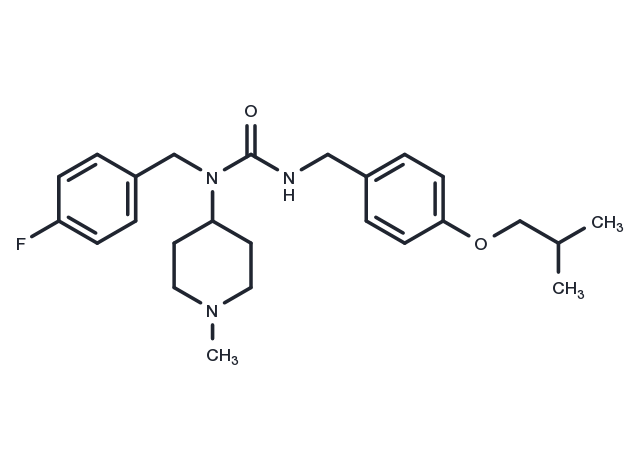Powder: -20°C for 3 years | In solvent: -80°C for 1 year
Pimavanserin (ACP-103)(ACP-103) is an effective and specific 5-HT2A receptor inverse agonist (mean pIC50: 8.7, in the cell-based functional assay). Pimavanserin is an atypical antipsychotic used in the treatment of hallucinations and psychosis in patients with Parkinson disease.

| パッケージサイズ | 在庫状況 | 単価(税別) | |||
|---|---|---|---|---|---|
| サンプルについてお問い合わせ | |||||
| 25 mg | 在庫あり | ¥ 10,500 | |||
| 50 mg | 在庫あり | ¥ 16,000 | |||
| 100 mg | お問い合わせ | ¥ 26,000 | |||
| 200 mg | お問い合わせ | ¥ 33,500 | |||
| 1 mL * 10 mM (in DMSO) | 在庫あり | ¥ 11,000 | |||
| 説明 | Pimavanserin (ACP-103)(ACP-103) is an effective and specific 5-HT2A receptor inverse agonist (mean pIC50: 8.7, in the cell-based functional assay). Pimavanserin is an atypical antipsychotic used in the treatment of hallucinations and psychosis in patients with Parkinson disease. |
| ターゲット&IC50 | 5-HT2A:8.7(pIC50) |
| In vitro | Pimavanserin (ACP-103) competitively antagonizes the binding of [3H]ketanserin to heterologously expressed human 5-HT2A receptors with a mean pKi of 9.3 in membranes and 9.70 in whole cells. Pimavanserin demonstrates lesser affinity (mean pKi of 8.80 in membranes and 8.00 in whole cells, as determined by radioligand binding) and potency as an inverse agonist (mean pIC50 7.1 in R-SAT) at human 5-HT2C receptors, and lacked affinity and functional activity at 5-HT2B receptors, dopamine D2 receptors, and other human monoaminergic receptors[1]. Pimavanserin (ACP-103) is highly selective for 5-HT2A receptors, lacking affinity for other receptors in a broad profile screen including 65 different molecular targets; the only other receptor for which Pimavanserin demonstrates affinity is 5-HT2C, and Pimavanserin is approximately 30-fold selective for 5-HT2A receptors over 5-HT2C receptors depending on the assay[2]. |
| In vivo | Pimavanserin (ACP-103) is a potent and effective orally active compound acting as a 5-HT2A receptor inverse agonist, demonstrating a pharmacological profile that suggests its potential as an antipsychotic agent. It mitigates head-twitch behavior (3 mg/kg p.o.) and prepulse inhibition deficits (1-10 mg/kg s.c.) triggered by the 5-HT2A receptor agonist (±)-2,5-dimethoxy-4-iodoamphetamine hydrochloride in rats. Additionally, pimavanserin reduces hyperactivity in mice caused by N-methyl-D-aspartate receptor antagonism via 5H-dibenzo[a,d]cyclohepten-5,10-imine (dizocilpine maleate; MK-801) at dosages of 0.1 and 0.3 mg/kg s.c. and 3 mg/kg p.o. These effects corroborate its in vivo mechanism of action through the 5-HT2A receptor and demonstrate its antipsychotic-like effectiveness. Moreover, pimavanserin shows an oral bioavailability exceeding 42.6% in rats[1]. |
| キナーゼ試験 | For the membrane binding, NIH-3T3 cells are grown to 70% confluence in 15 cm2 dishes and transfected with 10 μg of receptor plasmid DNA using Polyfect transfection reagent. Two days after transfection, cells expressing the desired serotonin receptor are homogenized in 20 mM HEPES/10 mM EDTA and spun down at 11,000 g at 4°C for 30 min. The supernatant is discarded, and the pellet is resuspended in 20 mM HEPES/1 mM EDTA and spun down at the same setting. The pellet is then resuspended in 20 mM HEPES/0.5 mM EDTA, and membranes are used for binding assays. Bradford analysis is used to determine total membrane protein. Kd and Bmax values are derived from 12-point concentration experiments using 1 nM [3H]ketanserin for the 5-HT2A receptor and 3 nM [3H]mesulergine for the 5-HT2B and 5-HT2C receptors. Membranes are incubated at room temperature for 3 h with various concentrations of test ligand in the presence of a fixed concentration of radioligand. The suspension is filtered as explained below for whole-cell binding, washed with ice-cold buffer, and dried, and radioactivity is determined using TopCount[1]. |
| 細胞研究 | Pimavanserin (ACP-103) is dissolved in DMSO and stored, and then diluted with appropriate media before use[1]. For the whole-cell binding, 6 million human embryonic kidney 293T cells are plated in 10-cm dishes and transfected with 5 μg of plasmid DNA using Polyfect. Two days after transfection, cells are harvested with 10 mM EDTA, washed, and resuspended in binding buffer (1× DMEM with 0.1% bovine serum albumin). Then, 60,000 cells transfected with the 5-HT2A receptor or 20,000 cells transfected with the 5-HT2C-INI receptor are incubated at 37°C for 3 h in the presence of 5 nM radioligand ([3H]ketanserin for 5-HT2A receptors and [3H]mesulergine for 5-HT2C-INI receptors) and varying concentrations of ligands (total volume 100 μL in a 96-well plate). Cells are filtered onto a 96-well GF/B filter plate and washed with 300 mL of wash buffer (25 mM HEPES, 1 mM CaCl2, 5 mM MgCl2, and 0.25 M NaCl) using a Filtermate 196 harvester. The filter plates are dried under a heat lamp before addition of 50 μL of scintillation fluid to each well. Plates are counted on a TopCount. Separately, the hydrochloride salt form of Pimavanserin (10 μM) is evaluated at MDS Pharma Services for activity in a broad screen of radioligand binding assays at 65 different receptors[1]. |
| 別名 | ACP-103 |
| 分子量 | 427.55 |
| 分子式 | C25H34FN3O2 |
| CAS No. | 706779-91-1 |
Powder: -20°C for 3 years | In solvent: -80°C for 1 year
DMSO: 60 mg/mL (140.33 mM)
You can also refer to dose conversion for different animals. 詳細
bottom
Please see Inhibitor Handling Instructions for more frequently ask questions. Topics include: how to prepare stock solutions, how to store products, and cautions on cell-based assays & animal experiments, etc.
Pimavanserin 706779-91-1 GPCR/G Protein Neuroscience 5-HT Receptor inhibit Serotonin Receptor ACP103 ACP-103 Inhibitor ACP 103 5-hydroxytryptamine Receptor inhibitor
